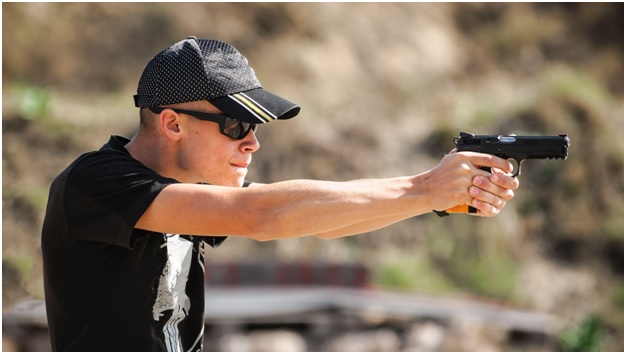Shooting a handgun is not easy. They are inherently cumbersome devices and by their small nature, there is less surface area in contact with the shooter’s hands. This makes them difficult to control and shoot accurately.
There is both a wrong way and a right way to hold a handgun. Maybe you won’t notice bad habits when plinking with a .22, but when you graduate to a hotter load like TulAmmo 9mm, 10mm Auto, or .45 ACP, you won’t be able to not notice bad habits any longer.
Here’s how to do it right, covering handgun grip and stance.
Dominant Hand
When you hold a handgun, you want to follow this maxim: high and tight.
You should place your dominant (shooting) hand as high on the grip as possible without coming in contact with the slide.
Wrap all three fingers fully around the grip. Your index finger should never come in contact with the trigger until you are ready to shoot. It should rest alongside the frame at the base of the slide.
The webbing between your thumb and index finger should come right up to the base of the slide, as high as possible without getting “slide bitten” when shooting.
This is because recoil originates in the barrel - the force directs straight back through the barrel towards the rear; the higher you can come up to the base of the slide, right beneath the barrel, the better.
Rest your shooting hand’s thumb forward along the frame at the base of the slide to create as much surface area contact between your shooting hand and the gun as possible.
Support Hand
With your support hand, the object is the same - to grip the gun high on the frame and maximize surface area contact between your grip and the gun.
Angle your support hand slightly forward, lay your support hand over the heel of your shooting hand, then wrap your fingers fully around the grip and over top of the three fingers of your shooting hand.
Your support hand’s index finger should come right up to the base of the trigger guard, or wrap around the front of it.
Your support hand’s thumb should lay right alongside your shooting hand’s thumb, but since it is angled forward, should extend past it along the frame at the base of the slide.
This will maximize surface area contact between your hands and the gun, helping to control recoil while shooting.
Lock Your Elbows and Wrists
When you extend the handgun to fire, you want to lock your elbows and wrists. This will require you to extend the firearm almost as fully from your body as possible.
Looking your elbows and wrists will help eliminate “play” in your joints, making it more difficult for the force of recoil to overpower your grip.
Hold It Tight
Another important suggestion is to grip the gun as tightly as you can without shaking. This is one degree shy of a death grip. Grip the gun hard.
Holding it as tightly as possible will help you absorb recoil when you pull the trigger and control muzzle flip, which will keep your sights aligned with the target.
A tight grip can help you improve accuracy, execute more rapid, more accurate follow up shots, and mitigate the progressive effects of recoil fatigue.
Adopting a Proper Stance

There isn’t necessarily a right or wrong shooting stance. You can choose to adopt a Weaver stance or an isosceles stance or some other established handgun shooting stance - but one thing you should also do, regardless of what stance you prefer, is drop your center of gravity and lean forward slightly.
Lowering your center of gravity and leaning forward will do two things. One, it will help you be more stable, and two, it will help you absorb some of the force of recoil, at the very least, making it harder for you to get knocked off balance.
What Will Happen If You Don’t Do It Right
Now that we’ve covered the basics of how to hold a handgun the right way, let’s talk about what happens if you don’t do it right.
First, the obvious. If you don’t hold the gun properly, you’re asking to get a whooping from recoil. Some cartridges kick harder than others, and if you shoot 10mm Auto all day with a low, limp grip on the gun and bent elbows, you’re going to be sore after a range session.
The other obvious thing is that not holding the gun properly makes it harder to keep your sights on target between shots, adding time to target reacqusition and generally adversely impacting accuracy.
But now, for the most adverse consequence of them all: the dreaded consequences of limp-wristing.
Limp-wristing occurs when you are holding the gun with a squid like grip and let it flop backwards under the force of recoil after firing.
When you limp-wrist a semi-automatic handgun with a slide action, allowing the gun to move backward with your wrists causes the slide to fail to eject the spent casing; it can also prevent the slide from feeding a new round into the chamber and resetting back into battery.
In short, limp-wristing cripples the semi-automatic action of a handgun with a slide by causing jams, whether it’s recoil or blowback operated.
Stock Up on Federal, Ammo, Inc, Blazer, and TulAmmo 9mm Here
Whether you’re shooting a light-kicking handgun cartridge like .22LR, something in the middle ground like TulAmmo 9mm Luger, or a hard-kicking cartridge like .45 ACP, we have them all. Check out our collection of handgun ammo, buy up, and keep these tips in mind the next time you’re at the range. See if your groups don’t respond favorably.

